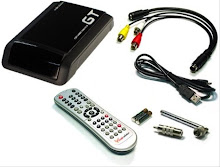Save Yourself a Bundle of Cash by Using Your PC Monitor to Watch High Definition Cable and Broadcast Channels
Although prices for high definition television sets have dropped dramatically, they still aren't cheap. If you want to watch high definition television without laying out for a new television set, you can easily watch HDTV on your computer monitor. Most monitors with a resolution of 1024x768 or higher can handle 720p content (which will still look very nice), and the majority of newer widescreen LCD monitors above 24" can display 1080p high definition content, which is the best format today. To watch this beautiful programming on your computer monitor, you'll need a HDTV tuner.
USB Makes it as Easy as Hooking Up a Mouse
Most people avoid messing around with the insides of their computers for fear of harming it or, at the very least, voiding the warranty. Fortunately, most HDTV tuners hook up to your computer through the USB port, like most mice and keyboards, making it easy for everyone to watch high definition programming right on their computers. The latest versions of Windows XP, Windows Vista and MacOS X can play high definition content right out of the box. All you'll need to do is install a driver (a small program that allows the HDTV tuner to communicate with the computer); in many cases your operating system will do this automatically as soon as you plug in the HDTV tuner. The majority of tuners will also include their own software for viewing and recording HDTV programming, but installation of this software should be optional for most tuners.
High Definition Providers
There wouldn't be much point in buying a HDTV tuner if there wasn't any content available to watch on it. Fortunately, many local television stations broadcast HDTV over the air for free and can be picked up just be plugging in an antenna. Most HDTV tuners come with an antenna, but the included antennas are generally only of passable quality and you will probably want to buy a better quality antenna to improve your reception.
All cable and satellite providers now provide high definition programming, and will often loan or rent a HDTV tuner to you. Some include HD content in their basic packages while others charge a premium for it. The majority provide HD programming from local television stations for free, and charge for access to HD specialty channels (TLC, Discovery, ESPN, etc.) even if the channel's standard definition programming is part of their basic cable package. It can be rather confusing, so the best way to find out is to call your cable provider or visit their website.
What About Blu-ray and HD-DVD?
HD-DVD and Blu-ray are quickly becoming popular options for watching high definition movies on DVD. It would be great to be able to watch high definition DVDs on your computer along with high definition television programming. Unfortunately, copyright concerns have prompted the manufacturers of both Blu-ray and HD-DVD to impose strict restrictions on playing high definition DVDs on computers. The short version is that you cannot install a Blu-ray of HD-DVD drive in your computer and watch high definition DVDs, nor can you hook up a stand-alone DVD player to a HDTV tuner. Your existing computer monitor may have HDMI inputs, which would allow you to plug a DVD player directly into the monitor, bypassing the computer itself. Otherwise, the only way to watch these DVDs on your computer is to purchase a new system from a major manufacturer (such as Dell or HP) which has been certified to play Blu-ray or HD-DVD. If you're in the market for a new computer, then purchasing one of these systems makes sense; otherwise, you're better off with a new HDTV television and a stand-alone Blu-ray or HD-DVD player.
The most important thing to do before purchasing any HDTV equipment is to figure out what you want to watch. If you only want to watch over-the-air HDTV broadcasts and don't want to spend a lot of money, a HDTV tuner will be the ideal purchase, at least until you can buy a HD television set. If you're a cable or satellite subscriber you may not need to buy anything, as your provider may loan or rent a HDTV tuner to you. And if you plan to watch high definition DVDs, you're going to need either a new computer or monitor, or a stand-alone DVD player and HD television set.
R James Cook is an HDTV aficionado, and contributes regularly to the Best HDTV Reviews website. Visit BestHDTVReviews.com for HDTV products, reviews, and information.
Article Source: http://EzineArticles.com/?expert=R_James_Cook



